Report on Accounting Fundamentals: Analyzing Wales and Sweet Plc
VerifiedAdded on 2023/06/13
|12
|2334
|170
Report
AI Summary
This report provides a comprehensive analysis of accounting fundamentals, focusing on the financial performance and position of Wales Plc and Sweet Plc. It includes the preparation of an income statement and statement of financial position for Wales Plc, along with an explanation of why the statement of financial position balances. Additionally, the report calculates and interprets various financial ratios for Sweet Plc for the years 2021 and 2020, offering insights into the company's profitability, liquidity, and efficiency. The analysis covers key metrics such as Return on Capital Employed (ROCE), Return on Equity (ROE), Earnings Per Share (EPS), Net Profit Margin, Asset Turnover, Stock Holding Days, Debtors Collection Period, Current Ratio, Gearing Ratio, and Interest Cover, providing a thorough assessment of Sweet Plc's financial health and performance trends.

ACCOUNTING
FUNDAMENTALS
1
FUNDAMENTALS
1
Paraphrase This Document
Need a fresh take? Get an instant paraphrase of this document with our AI Paraphraser
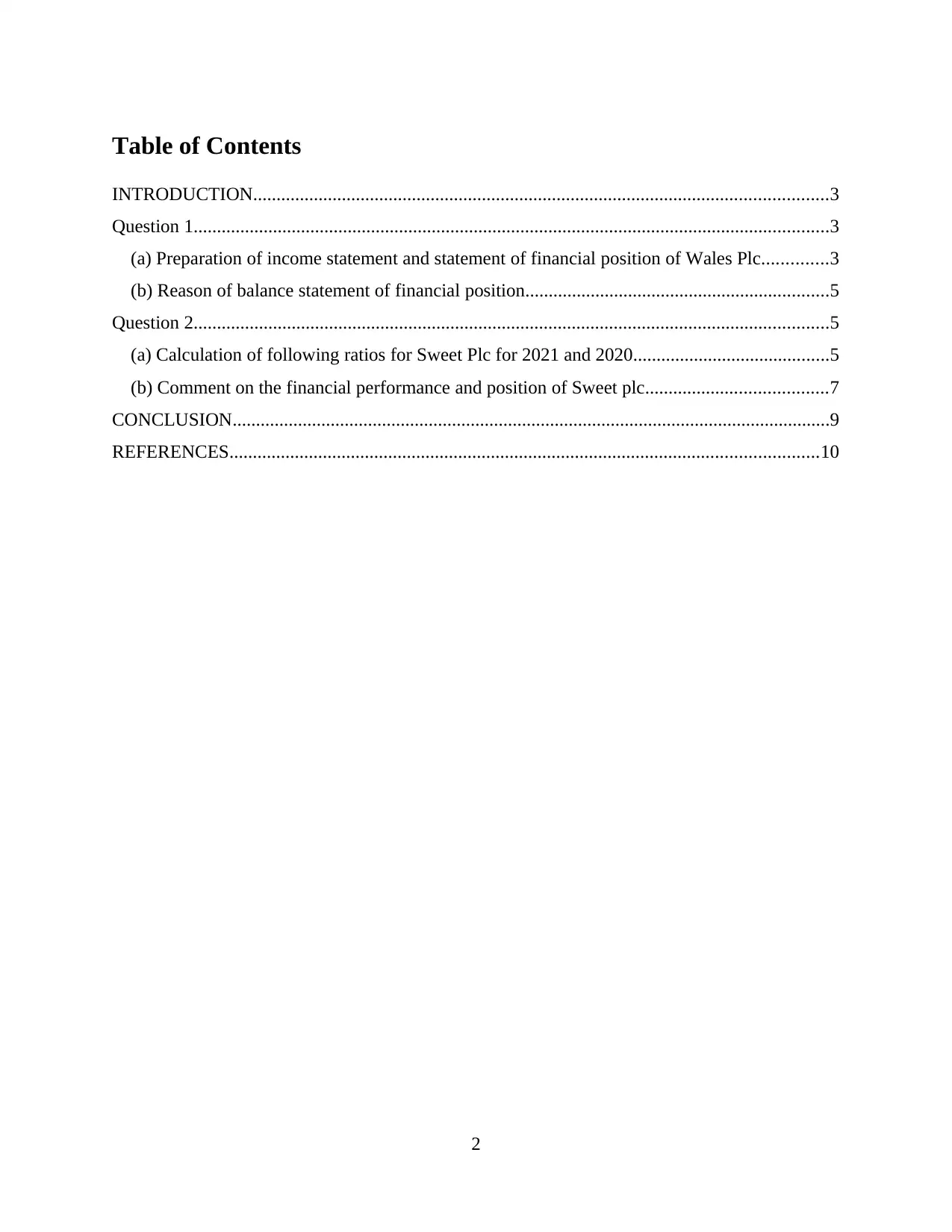
Table of Contents
INTRODUCTION...........................................................................................................................3
Question 1........................................................................................................................................3
(a) Preparation of income statement and statement of financial position of Wales Plc..............3
(b) Reason of balance statement of financial position.................................................................5
Question 2........................................................................................................................................5
(a) Calculation of following ratios for Sweet Plc for 2021 and 2020..........................................5
(b) Comment on the financial performance and position of Sweet plc.......................................7
CONCLUSION................................................................................................................................9
REFERENCES..............................................................................................................................10
2
INTRODUCTION...........................................................................................................................3
Question 1........................................................................................................................................3
(a) Preparation of income statement and statement of financial position of Wales Plc..............3
(b) Reason of balance statement of financial position.................................................................5
Question 2........................................................................................................................................5
(a) Calculation of following ratios for Sweet Plc for 2021 and 2020..........................................5
(b) Comment on the financial performance and position of Sweet plc.......................................7
CONCLUSION................................................................................................................................9
REFERENCES..............................................................................................................................10
2
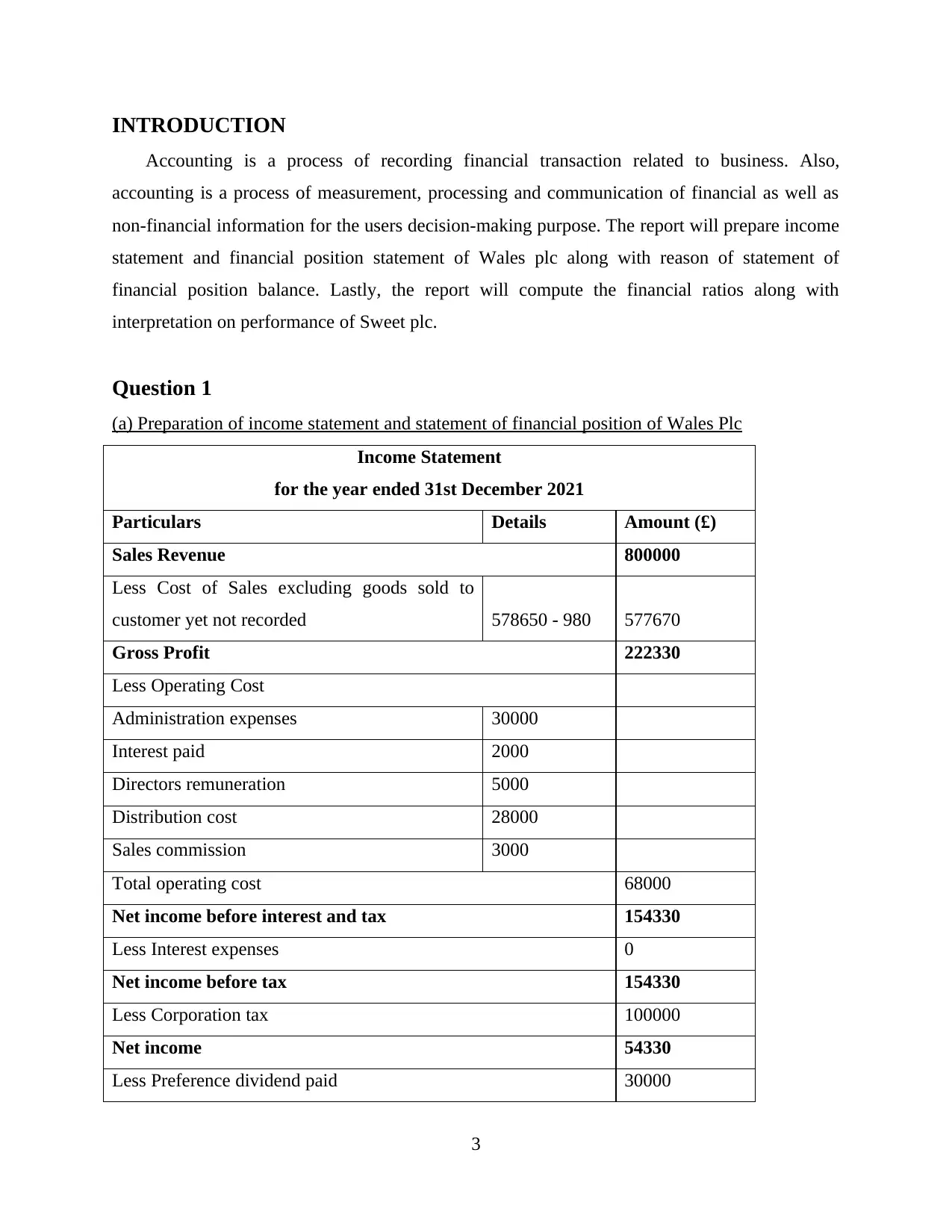
INTRODUCTION
Accounting is a process of recording financial transaction related to business. Also,
accounting is a process of measurement, processing and communication of financial as well as
non-financial information for the users decision-making purpose. The report will prepare income
statement and financial position statement of Wales plc along with reason of statement of
financial position balance. Lastly, the report will compute the financial ratios along with
interpretation on performance of Sweet plc.
Question 1
(a) Preparation of income statement and statement of financial position of Wales Plc
Income Statement
for the year ended 31st December 2021
Particulars Details Amount (£)
Sales Revenue 800000
Less Cost of Sales excluding goods sold to
customer yet not recorded 578650 - 980 577670
Gross Profit 222330
Less Operating Cost
Administration expenses 30000
Interest paid 2000
Directors remuneration 5000
Distribution cost 28000
Sales commission 3000
Total operating cost 68000
Net income before interest and tax 154330
Less Interest expenses 0
Net income before tax 154330
Less Corporation tax 100000
Net income 54330
Less Preference dividend paid 30000
3
Accounting is a process of recording financial transaction related to business. Also,
accounting is a process of measurement, processing and communication of financial as well as
non-financial information for the users decision-making purpose. The report will prepare income
statement and financial position statement of Wales plc along with reason of statement of
financial position balance. Lastly, the report will compute the financial ratios along with
interpretation on performance of Sweet plc.
Question 1
(a) Preparation of income statement and statement of financial position of Wales Plc
Income Statement
for the year ended 31st December 2021
Particulars Details Amount (£)
Sales Revenue 800000
Less Cost of Sales excluding goods sold to
customer yet not recorded 578650 - 980 577670
Gross Profit 222330
Less Operating Cost
Administration expenses 30000
Interest paid 2000
Directors remuneration 5000
Distribution cost 28000
Sales commission 3000
Total operating cost 68000
Net income before interest and tax 154330
Less Interest expenses 0
Net income before tax 154330
Less Corporation tax 100000
Net income 54330
Less Preference dividend paid 30000
3
⊘ This is a preview!⊘
Do you want full access?
Subscribe today to unlock all pages.

Trusted by 1+ million students worldwide

Net income available for equity shareholders 24330
Statement of financial position
as at 31st December 2021
Particulars Details Amount (£)
ASSETS
Non-current assets
Plant and Equipment 632730
Current assets
Inventory 330600
Trade receivable + goods sold to customer not
yet recorded (170125 + 980) 171105
Cash and bank 76250
Total Current assets 577955
Total assets 1210685
EQUITY AND LIABILITIES
Current liabilities
Trade payable 171355
Tax payable 100000
Sales commission payable 3000
Total current liability 274355
Non-current liability
4% Debentures 100000
Net assets 836330
4
Statement of financial position
as at 31st December 2021
Particulars Details Amount (£)
ASSETS
Non-current assets
Plant and Equipment 632730
Current assets
Inventory 330600
Trade receivable + goods sold to customer not
yet recorded (170125 + 980) 171105
Cash and bank 76250
Total Current assets 577955
Total assets 1210685
EQUITY AND LIABILITIES
Current liabilities
Trade payable 171355
Tax payable 100000
Sales commission payable 3000
Total current liability 274355
Non-current liability
4% Debentures 100000
Net assets 836330
4
Paraphrase This Document
Need a fresh take? Get an instant paraphrase of this document with our AI Paraphraser
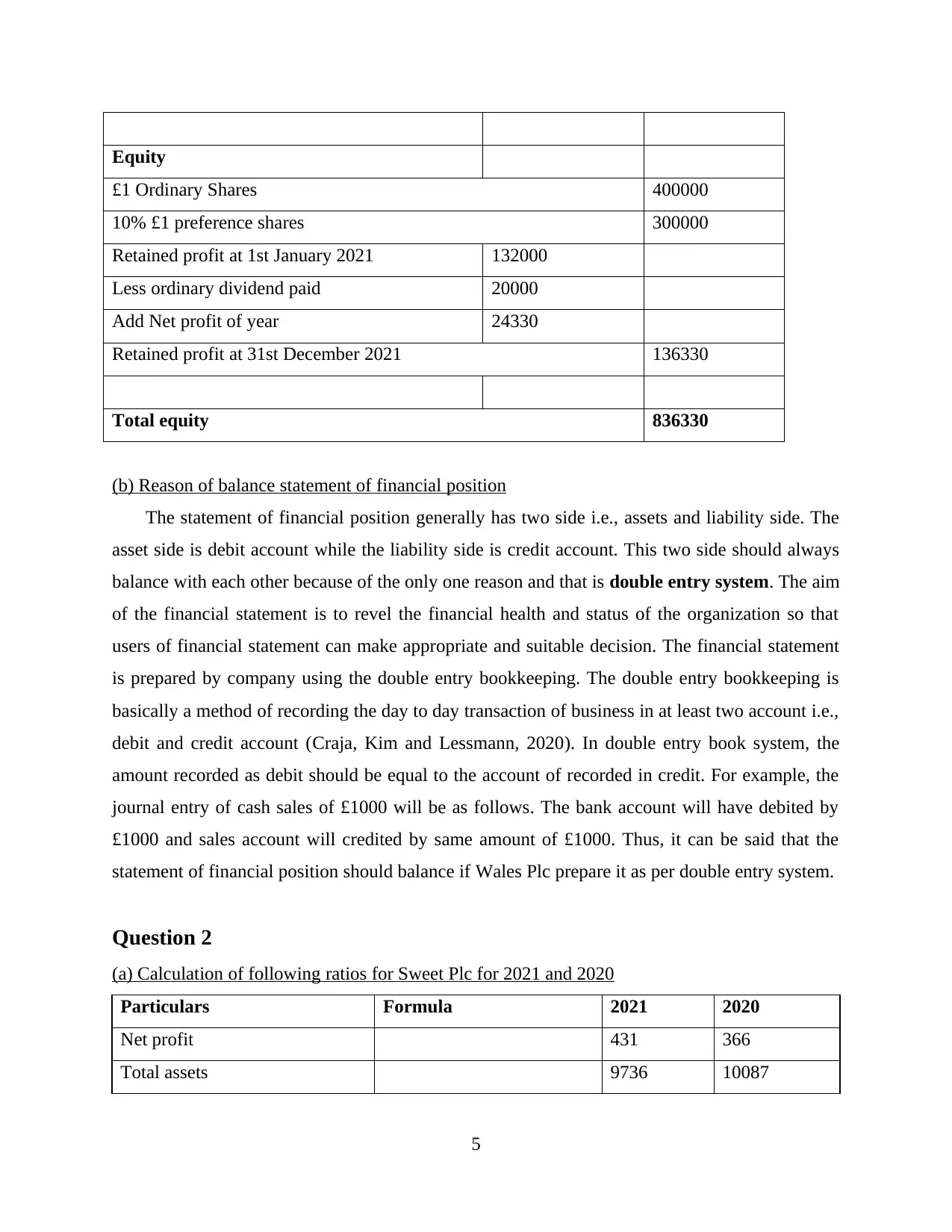
Equity
£1 Ordinary Shares 400000
10% £1 preference shares 300000
Retained profit at 1st January 2021 132000
Less ordinary dividend paid 20000
Add Net profit of year 24330
Retained profit at 31st December 2021 136330
Total equity 836330
(b) Reason of balance statement of financial position
The statement of financial position generally has two side i.e., assets and liability side. The
asset side is debit account while the liability side is credit account. This two side should always
balance with each other because of the only one reason and that is double entry system. The aim
of the financial statement is to revel the financial health and status of the organization so that
users of financial statement can make appropriate and suitable decision. The financial statement
is prepared by company using the double entry bookkeeping. The double entry bookkeeping is
basically a method of recording the day to day transaction of business in at least two account i.e.,
debit and credit account (Craja, Kim and Lessmann, 2020). In double entry book system, the
amount recorded as debit should be equal to the account of recorded in credit. For example, the
journal entry of cash sales of £1000 will be as follows. The bank account will have debited by
£1000 and sales account will credited by same amount of £1000. Thus, it can be said that the
statement of financial position should balance if Wales Plc prepare it as per double entry system.
Question 2
(a) Calculation of following ratios for Sweet Plc for 2021 and 2020
Particulars Formula 2021 2020
Net profit 431 366
Total assets 9736 10087
5
£1 Ordinary Shares 400000
10% £1 preference shares 300000
Retained profit at 1st January 2021 132000
Less ordinary dividend paid 20000
Add Net profit of year 24330
Retained profit at 31st December 2021 136330
Total equity 836330
(b) Reason of balance statement of financial position
The statement of financial position generally has two side i.e., assets and liability side. The
asset side is debit account while the liability side is credit account. This two side should always
balance with each other because of the only one reason and that is double entry system. The aim
of the financial statement is to revel the financial health and status of the organization so that
users of financial statement can make appropriate and suitable decision. The financial statement
is prepared by company using the double entry bookkeeping. The double entry bookkeeping is
basically a method of recording the day to day transaction of business in at least two account i.e.,
debit and credit account (Craja, Kim and Lessmann, 2020). In double entry book system, the
amount recorded as debit should be equal to the account of recorded in credit. For example, the
journal entry of cash sales of £1000 will be as follows. The bank account will have debited by
£1000 and sales account will credited by same amount of £1000. Thus, it can be said that the
statement of financial position should balance if Wales Plc prepare it as per double entry system.
Question 2
(a) Calculation of following ratios for Sweet Plc for 2021 and 2020
Particulars Formula 2021 2020
Net profit 431 366
Total assets 9736 10087
5
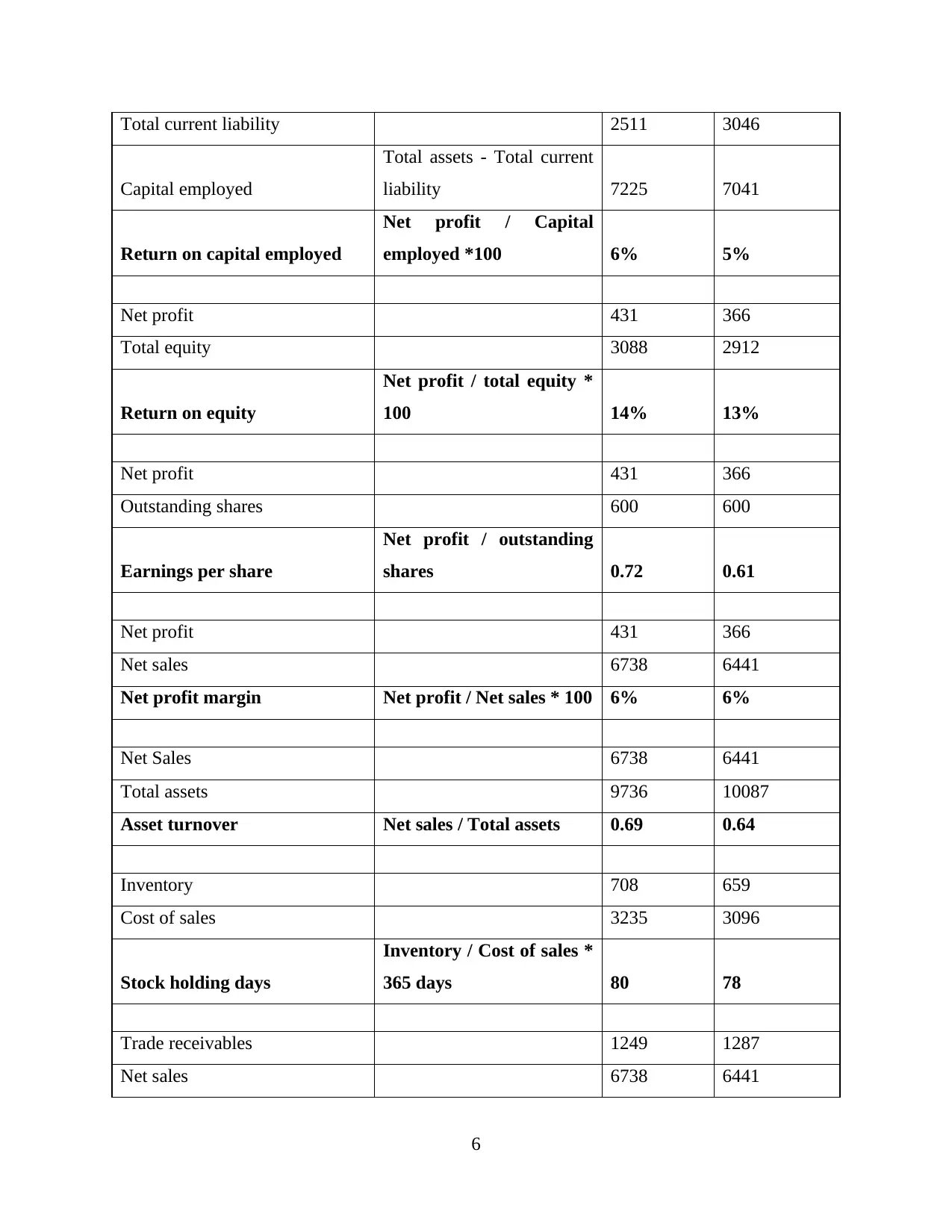
Total current liability 2511 3046
Capital employed
Total assets - Total current
liability 7225 7041
Return on capital employed
Net profit / Capital
employed *100 6% 5%
Net profit 431 366
Total equity 3088 2912
Return on equity
Net profit / total equity *
100 14% 13%
Net profit 431 366
Outstanding shares 600 600
Earnings per share
Net profit / outstanding
shares 0.72 0.61
Net profit 431 366
Net sales 6738 6441
Net profit margin Net profit / Net sales * 100 6% 6%
Net Sales 6738 6441
Total assets 9736 10087
Asset turnover Net sales / Total assets 0.69 0.64
Inventory 708 659
Cost of sales 3235 3096
Stock holding days
Inventory / Cost of sales *
365 days 80 78
Trade receivables 1249 1287
Net sales 6738 6441
6
Capital employed
Total assets - Total current
liability 7225 7041
Return on capital employed
Net profit / Capital
employed *100 6% 5%
Net profit 431 366
Total equity 3088 2912
Return on equity
Net profit / total equity *
100 14% 13%
Net profit 431 366
Outstanding shares 600 600
Earnings per share
Net profit / outstanding
shares 0.72 0.61
Net profit 431 366
Net sales 6738 6441
Net profit margin Net profit / Net sales * 100 6% 6%
Net Sales 6738 6441
Total assets 9736 10087
Asset turnover Net sales / Total assets 0.69 0.64
Inventory 708 659
Cost of sales 3235 3096
Stock holding days
Inventory / Cost of sales *
365 days 80 78
Trade receivables 1249 1287
Net sales 6738 6441
6
⊘ This is a preview!⊘
Do you want full access?
Subscribe today to unlock all pages.

Trusted by 1+ million students worldwide

Debtors collection period
Trade receivables / Net
Sales * 365 days 68 73
Current assets 2303 2355
Current liabilities 2511 3046
Current ratio
Current assets / Current
liabilities 0.92 0.77
Total debt 6648 7175
Total equity 3088 2912
Gearing ratio Total debt / Total equity 2.15 2.46
Interest expenses 226 181
Earnings before interest and
expenses / Operating profit 805 699
Interest cover ratio
Earnings before interest
and tax / Interest expenses 0.28 0.26
(b) Comment on the financial performance and position of Sweet plc
The financial health and performance of Sweet Plc as per the ratio calculated above are as
follows:
Return on Capital employed (ROCE): This is a ratio which indicate the capability of
the company to use its capital for generating revenue. On the basis of above calculation, it is
analysed that ROCE of Sweet plc in the year 2021 is 6% that is higher than the previous year of
5%. This means that the capability of Sweet plc to generate profit from its capital employed is
good and high. This indicate better profitability position of business. In order to further improve
it, the management of Sweet plc need to increase its operating profit or reduce its value of capital
employed by selling outdated assets (Durocher and Fortin, 2021).
Return on equity (ROE): This is another measure of profitability which indicate
capability of organisation to generate return on equity (assets minus liabilities). After analysing
calculation, it is identified that the ROE of Sweet plc in the current year i.e., 2021 is 14% as
7
Trade receivables / Net
Sales * 365 days 68 73
Current assets 2303 2355
Current liabilities 2511 3046
Current ratio
Current assets / Current
liabilities 0.92 0.77
Total debt 6648 7175
Total equity 3088 2912
Gearing ratio Total debt / Total equity 2.15 2.46
Interest expenses 226 181
Earnings before interest and
expenses / Operating profit 805 699
Interest cover ratio
Earnings before interest
and tax / Interest expenses 0.28 0.26
(b) Comment on the financial performance and position of Sweet plc
The financial health and performance of Sweet Plc as per the ratio calculated above are as
follows:
Return on Capital employed (ROCE): This is a ratio which indicate the capability of
the company to use its capital for generating revenue. On the basis of above calculation, it is
analysed that ROCE of Sweet plc in the year 2021 is 6% that is higher than the previous year of
5%. This means that the capability of Sweet plc to generate profit from its capital employed is
good and high. This indicate better profitability position of business. In order to further improve
it, the management of Sweet plc need to increase its operating profit or reduce its value of capital
employed by selling outdated assets (Durocher and Fortin, 2021).
Return on equity (ROE): This is another measure of profitability which indicate
capability of organisation to generate return on equity (assets minus liabilities). After analysing
calculation, it is identified that the ROE of Sweet plc in the current year i.e., 2021 is 14% as
7
Paraphrase This Document
Need a fresh take? Get an instant paraphrase of this document with our AI Paraphraser
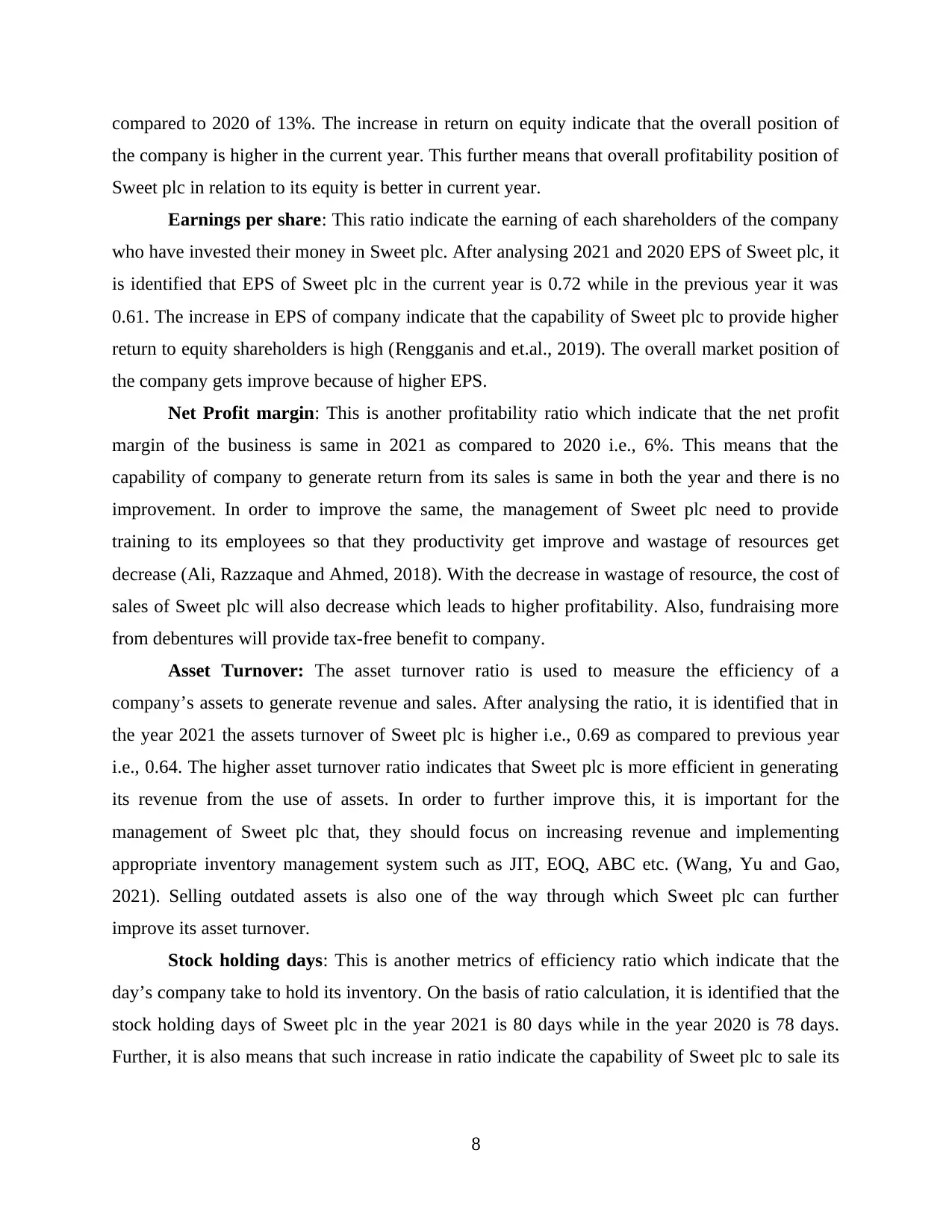
compared to 2020 of 13%. The increase in return on equity indicate that the overall position of
the company is higher in the current year. This further means that overall profitability position of
Sweet plc in relation to its equity is better in current year.
Earnings per share: This ratio indicate the earning of each shareholders of the company
who have invested their money in Sweet plc. After analysing 2021 and 2020 EPS of Sweet plc, it
is identified that EPS of Sweet plc in the current year is 0.72 while in the previous year it was
0.61. The increase in EPS of company indicate that the capability of Sweet plc to provide higher
return to equity shareholders is high (Rengganis and et.al., 2019). The overall market position of
the company gets improve because of higher EPS.
Net Profit margin: This is another profitability ratio which indicate that the net profit
margin of the business is same in 2021 as compared to 2020 i.e., 6%. This means that the
capability of company to generate return from its sales is same in both the year and there is no
improvement. In order to improve the same, the management of Sweet plc need to provide
training to its employees so that they productivity get improve and wastage of resources get
decrease (Ali, Razzaque and Ahmed, 2018). With the decrease in wastage of resource, the cost of
sales of Sweet plc will also decrease which leads to higher profitability. Also, fundraising more
from debentures will provide tax-free benefit to company.
Asset Turnover: The asset turnover ratio is used to measure the efficiency of a
company’s assets to generate revenue and sales. After analysing the ratio, it is identified that in
the year 2021 the assets turnover of Sweet plc is higher i.e., 0.69 as compared to previous year
i.e., 0.64. The higher asset turnover ratio indicates that Sweet plc is more efficient in generating
its revenue from the use of assets. In order to further improve this, it is important for the
management of Sweet plc that, they should focus on increasing revenue and implementing
appropriate inventory management system such as JIT, EOQ, ABC etc. (Wang, Yu and Gao,
2021). Selling outdated assets is also one of the way through which Sweet plc can further
improve its asset turnover.
Stock holding days: This is another metrics of efficiency ratio which indicate that the
day’s company take to hold its inventory. On the basis of ratio calculation, it is identified that the
stock holding days of Sweet plc in the year 2021 is 80 days while in the year 2020 is 78 days.
Further, it is also means that such increase in ratio indicate the capability of Sweet plc to sale its
8
the company is higher in the current year. This further means that overall profitability position of
Sweet plc in relation to its equity is better in current year.
Earnings per share: This ratio indicate the earning of each shareholders of the company
who have invested their money in Sweet plc. After analysing 2021 and 2020 EPS of Sweet plc, it
is identified that EPS of Sweet plc in the current year is 0.72 while in the previous year it was
0.61. The increase in EPS of company indicate that the capability of Sweet plc to provide higher
return to equity shareholders is high (Rengganis and et.al., 2019). The overall market position of
the company gets improve because of higher EPS.
Net Profit margin: This is another profitability ratio which indicate that the net profit
margin of the business is same in 2021 as compared to 2020 i.e., 6%. This means that the
capability of company to generate return from its sales is same in both the year and there is no
improvement. In order to improve the same, the management of Sweet plc need to provide
training to its employees so that they productivity get improve and wastage of resources get
decrease (Ali, Razzaque and Ahmed, 2018). With the decrease in wastage of resource, the cost of
sales of Sweet plc will also decrease which leads to higher profitability. Also, fundraising more
from debentures will provide tax-free benefit to company.
Asset Turnover: The asset turnover ratio is used to measure the efficiency of a
company’s assets to generate revenue and sales. After analysing the ratio, it is identified that in
the year 2021 the assets turnover of Sweet plc is higher i.e., 0.69 as compared to previous year
i.e., 0.64. The higher asset turnover ratio indicates that Sweet plc is more efficient in generating
its revenue from the use of assets. In order to further improve this, it is important for the
management of Sweet plc that, they should focus on increasing revenue and implementing
appropriate inventory management system such as JIT, EOQ, ABC etc. (Wang, Yu and Gao,
2021). Selling outdated assets is also one of the way through which Sweet plc can further
improve its asset turnover.
Stock holding days: This is another metrics of efficiency ratio which indicate that the
day’s company take to hold its inventory. On the basis of ratio calculation, it is identified that the
stock holding days of Sweet plc in the year 2021 is 80 days while in the year 2020 is 78 days.
Further, it is also means that such increase in ratio indicate the capability of Sweet plc to sale its
8
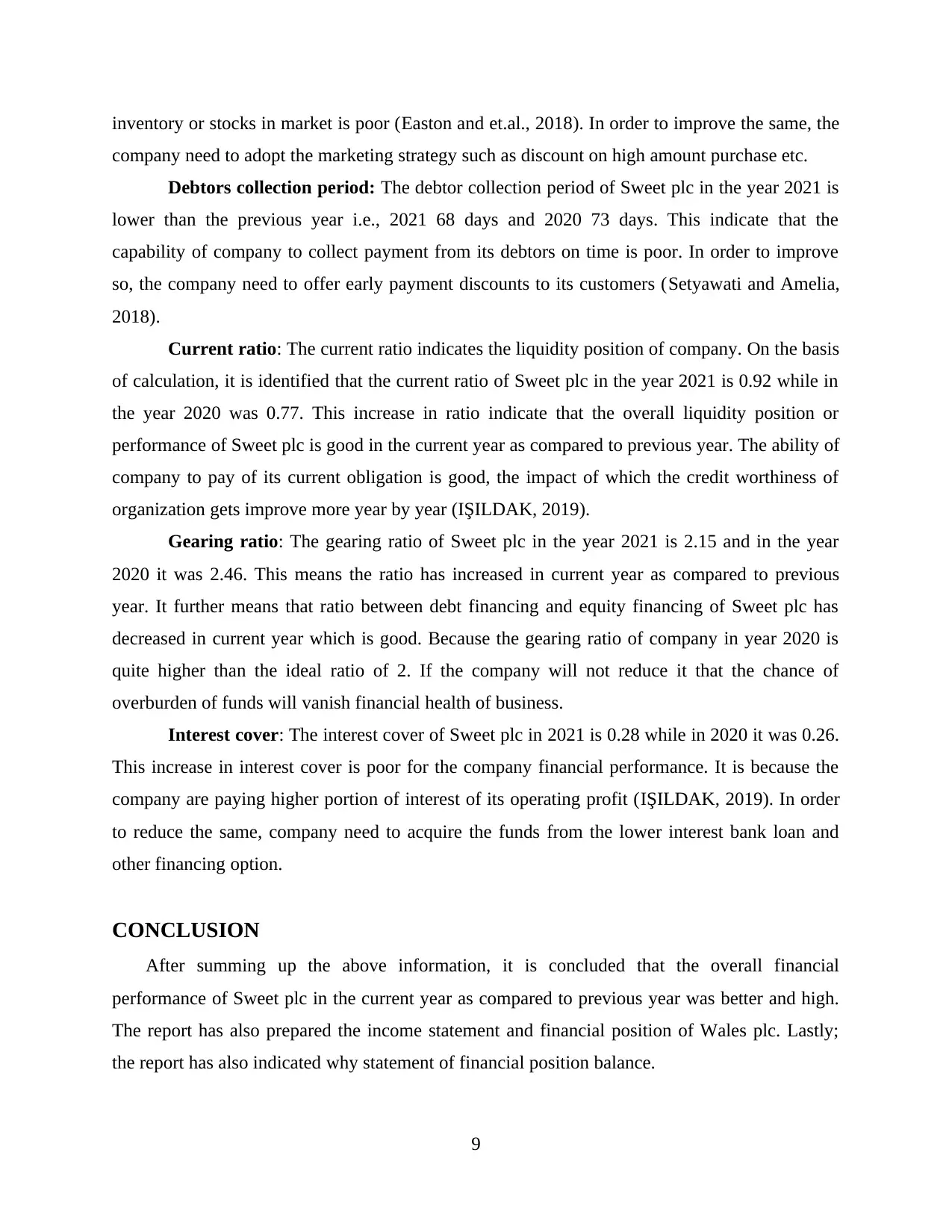
inventory or stocks in market is poor (Easton and et.al., 2018). In order to improve the same, the
company need to adopt the marketing strategy such as discount on high amount purchase etc.
Debtors collection period: The debtor collection period of Sweet plc in the year 2021 is
lower than the previous year i.e., 2021 68 days and 2020 73 days. This indicate that the
capability of company to collect payment from its debtors on time is poor. In order to improve
so, the company need to offer early payment discounts to its customers (Setyawati and Amelia,
2018).
Current ratio: The current ratio indicates the liquidity position of company. On the basis
of calculation, it is identified that the current ratio of Sweet plc in the year 2021 is 0.92 while in
the year 2020 was 0.77. This increase in ratio indicate that the overall liquidity position or
performance of Sweet plc is good in the current year as compared to previous year. The ability of
company to pay of its current obligation is good, the impact of which the credit worthiness of
organization gets improve more year by year (IŞILDAK, 2019).
Gearing ratio: The gearing ratio of Sweet plc in the year 2021 is 2.15 and in the year
2020 it was 2.46. This means the ratio has increased in current year as compared to previous
year. It further means that ratio between debt financing and equity financing of Sweet plc has
decreased in current year which is good. Because the gearing ratio of company in year 2020 is
quite higher than the ideal ratio of 2. If the company will not reduce it that the chance of
overburden of funds will vanish financial health of business.
Interest cover: The interest cover of Sweet plc in 2021 is 0.28 while in 2020 it was 0.26.
This increase in interest cover is poor for the company financial performance. It is because the
company are paying higher portion of interest of its operating profit (IŞILDAK, 2019). In order
to reduce the same, company need to acquire the funds from the lower interest bank loan and
other financing option.
CONCLUSION
After summing up the above information, it is concluded that the overall financial
performance of Sweet plc in the current year as compared to previous year was better and high.
The report has also prepared the income statement and financial position of Wales plc. Lastly;
the report has also indicated why statement of financial position balance.
9
company need to adopt the marketing strategy such as discount on high amount purchase etc.
Debtors collection period: The debtor collection period of Sweet plc in the year 2021 is
lower than the previous year i.e., 2021 68 days and 2020 73 days. This indicate that the
capability of company to collect payment from its debtors on time is poor. In order to improve
so, the company need to offer early payment discounts to its customers (Setyawati and Amelia,
2018).
Current ratio: The current ratio indicates the liquidity position of company. On the basis
of calculation, it is identified that the current ratio of Sweet plc in the year 2021 is 0.92 while in
the year 2020 was 0.77. This increase in ratio indicate that the overall liquidity position or
performance of Sweet plc is good in the current year as compared to previous year. The ability of
company to pay of its current obligation is good, the impact of which the credit worthiness of
organization gets improve more year by year (IŞILDAK, 2019).
Gearing ratio: The gearing ratio of Sweet plc in the year 2021 is 2.15 and in the year
2020 it was 2.46. This means the ratio has increased in current year as compared to previous
year. It further means that ratio between debt financing and equity financing of Sweet plc has
decreased in current year which is good. Because the gearing ratio of company in year 2020 is
quite higher than the ideal ratio of 2. If the company will not reduce it that the chance of
overburden of funds will vanish financial health of business.
Interest cover: The interest cover of Sweet plc in 2021 is 0.28 while in 2020 it was 0.26.
This increase in interest cover is poor for the company financial performance. It is because the
company are paying higher portion of interest of its operating profit (IŞILDAK, 2019). In order
to reduce the same, company need to acquire the funds from the lower interest bank loan and
other financing option.
CONCLUSION
After summing up the above information, it is concluded that the overall financial
performance of Sweet plc in the current year as compared to previous year was better and high.
The report has also prepared the income statement and financial position of Wales plc. Lastly;
the report has also indicated why statement of financial position balance.
9
⊘ This is a preview!⊘
Do you want full access?
Subscribe today to unlock all pages.

Trusted by 1+ million students worldwide

10
Paraphrase This Document
Need a fresh take? Get an instant paraphrase of this document with our AI Paraphraser

REFERENCES
Books and journals
Craja, P., Kim, A. and Lessmann, S., 2020. Deep learning for detecting financial statement
fraud. Decision Support Systems. 139. p.113421.
Durocher, S. and Fortin, A., 2021. Financial statement users’ institutional logic. Journal of
Accounting and Public Policy. 40(2). p.106819.
Rengganis, R. M. Y. D. and et.al., 2019. The fraud diamond: element in detecting financial
statement of fraud. International research journal of management, IT and social
sciences. 6(3). pp.1-10.
Ali, M. J., Razzaque, R. M. and Ahmed, K., 2018. Real earnings management and financial
statement fraud: evidence from Malaysia. International Journal of Accounting &
Information Management.
Wang, Y., Yu, M. and Gao, S., 2021. Gender diversity and financial statement fraud. Journal of
Accounting and Public Policy, p.106903.
Easton, P. D. and et.al., 2018. Financial statement analysis & valuation. Boston, MA:
Cambridge Business Publishers.
Setyawati, I. and Amelia, R., 2018. The role of current ratio, operating cash flow and inflation
rate in predicting financial distress: Indonesia Stock Exchange. JDM (Jurnal Dinamika
Manajemen). 9(2). pp.140-148.
IŞILDAK, M. S., 2019. Investigation of the Effect of Financial Ratios on Market Value/Book
Value Ratio by Panel Data Analysis: Application in BİST Registered Weaving, Garment
and Leather Sector. Ekonomik Yaklasim. 30(111). pp.71-100.
11
Books and journals
Craja, P., Kim, A. and Lessmann, S., 2020. Deep learning for detecting financial statement
fraud. Decision Support Systems. 139. p.113421.
Durocher, S. and Fortin, A., 2021. Financial statement users’ institutional logic. Journal of
Accounting and Public Policy. 40(2). p.106819.
Rengganis, R. M. Y. D. and et.al., 2019. The fraud diamond: element in detecting financial
statement of fraud. International research journal of management, IT and social
sciences. 6(3). pp.1-10.
Ali, M. J., Razzaque, R. M. and Ahmed, K., 2018. Real earnings management and financial
statement fraud: evidence from Malaysia. International Journal of Accounting &
Information Management.
Wang, Y., Yu, M. and Gao, S., 2021. Gender diversity and financial statement fraud. Journal of
Accounting and Public Policy, p.106903.
Easton, P. D. and et.al., 2018. Financial statement analysis & valuation. Boston, MA:
Cambridge Business Publishers.
Setyawati, I. and Amelia, R., 2018. The role of current ratio, operating cash flow and inflation
rate in predicting financial distress: Indonesia Stock Exchange. JDM (Jurnal Dinamika
Manajemen). 9(2). pp.140-148.
IŞILDAK, M. S., 2019. Investigation of the Effect of Financial Ratios on Market Value/Book
Value Ratio by Panel Data Analysis: Application in BİST Registered Weaving, Garment
and Leather Sector. Ekonomik Yaklasim. 30(111). pp.71-100.
11

12
⊘ This is a preview!⊘
Do you want full access?
Subscribe today to unlock all pages.

Trusted by 1+ million students worldwide
1 out of 12
Related Documents
Your All-in-One AI-Powered Toolkit for Academic Success.
+13062052269
info@desklib.com
Available 24*7 on WhatsApp / Email
![[object Object]](/_next/static/media/star-bottom.7253800d.svg)
Unlock your academic potential
Copyright © 2020–2025 A2Z Services. All Rights Reserved. Developed and managed by ZUCOL.




